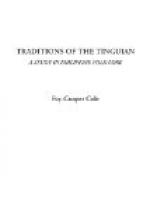Preface
The following myths were collected by the writer in 1907-8 during a stay of sixteen months with the Tinguian, a pagan tribe of northwestern Luzon in the Philippines. The material, for the most part gathered in texts, was partially translated in the Islands, while the balance was worked over during a brief visit to America in 1909. In this task I was assisted by Dumagat, a full blood Tinguian, who accompanied me.
While not, in all cases, giving a literal rendering, I have endeavored to follow closely the language of the story-tellers rather than to offer a polished translation. In some cases, where it was impossible to record the tales when heard, only the substance was noted, a fact which will account for the meagerness of detail evident in a few of the stories.
The Tinguian tribe numbers about twenty thousand individuals, most of whom are found in the sub-province of Abra, and in the mountains of Ilocos Sur and Norte. Their material culture, beliefs, and ceremonials are quite uniform and exceedingly complex. It is my intention to publish a study of this people in the near future, but realizing that it will be quite impossible for readers unacquainted with Tinguian life to understand many references in the tales, I have added such foot notes as will enable them to grasp the meaning of certain obscure passages.
In the introduction, an attempt has been made to bring together the culture of the people as it appears in the myths, and to contrast it with present day conditions and beliefs. In this way we may hope to gain a clearer insight into their mental life, and to secure a better idea of the values they attach to certain of their activities than is afforded us by actual observation or by direct inquiry. It is also possible that the tales may give us a glimpse of the early conditions under which this people developed, of their life and culture before the advent of the European.
It should be noted at the outset that no attempt is here made to reconstruct an actual historical period. As will appear later, a part of the material is evidently very old; later introductions—to which approximate dates may be assigned—have assumed places of great importance; while the stories doubtless owe much to the creative imaginations of successive story-tellers.
A comparison of these tales with the folk-lore of neighboring tribes would be of greatest value, but unfortunately very little material for such a study is available. Under the circumstances it has seemed best to defer the attempt and to call attention in the footnotes to striking similarities with other fields.
In the main these tales are so closely associated with the religious beliefs of the present day that it is unlikely they will be found, in anything approaching their present form, outside the districts dominated by this tribe. Nevertheless, isolated incidents corresponding to those of neighboring peoples or even of distant lands occur several times.




